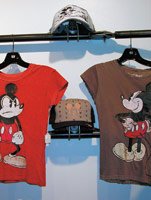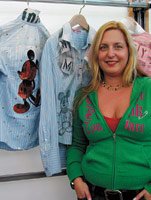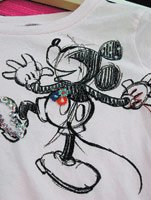Fashioning Tomorrowland: Disney's Licensing Program Gets Edgy
Skip Snead is used to dealing with edgy clients such as Rusty and Hot Topic at his 4- year-old private-label surfwear company, Chronic Industries Merchandising. But, in September 2003, the former Surfing magazine editor showed a trucker hat plastered with beer labels to The Walt Disney Co.
“We saw an opportunity with Disney in that they didn’t have any trucker hats,” Snead recalled.
He said Disney executives were curious about what Costa Mesa, Calif.–based Chronic could do for them. A year after the meeting, Snead officially launched hats decorated with Disney characters. He displayed his creations in Disney’s lounge at the MAGIC trade show in Las Vegas in August 2004 and shipped his first order four months later.
“It’s such a new direction for Disney,” said Snead, whose hats wholesale for $11. “We’re helping them be cool in the apparel industry.”
It may have been unthinkable a few years ago to utter Mickey Mouse and beer in the same breath, let alone Disney and cool. But through deals made with Chronic, Fred Segal and other leading fashion brands, 82-year-old Disney is being rejuvenated. Under the guidance of Andrew Mooney, Roger Wyett and Dennis Green—marketing veterans who are all alumni of footwear concern Nike Inc.—the Burbank, Calif.–based company is attempting to reach teenagers and young adults who dumped Mickey when they graduated kindergarten.
“We miss that kid from 6 to 26,” said Green, who is Disney’s senior vice president of global creative. “It’s good to have a mix with traditional licensees and licensees like Skip who are a little edgier and willing to take a chance. Disney hasn’t traditionally played well in the teen-age zone because that is a tough market to go over.”
Disney has been wooing that coveted market with, among other items, a pink cashmere sweater featuring a preening Tinkerbell from Disney Vintage, a deconstructed T-shirt of an angry Mickey Mouse made by Jem Sportswear for Walt Disney Collection and a brown mouse-printed trucker hat from Chronic that suggests Louis Vuitton’s logo pattern. Disney also hit it big last year when Karl Lagerfeld gave Donald Duck a makeover for the character’s 70th birthday and Dolce & Gabbana incorporated a Donald T-shirt into its Autumn/ Winter 2004/2005 runway show.
A recent issue of Forbes magazine estimated that sales of Mickey Mouse–branded products and licensing revenue were $5.8 billion in 2004, up from $4.6 billion in 2003. Much of that increase has resulted from the high-end efforts Disney made with Fred Segal and Dolce & Gabbana, a Disney spokesperson said. According to corporate filings, revenue from Disney’s consumer products division—which encompasses 16 lines, including toys and apparel— grew roughly 7 percent to $2.51 billion in the fiscal year ended Sept. 30, 2004, from $2.34 billion a year ago. Disney said merchandise licensing for consumer products increased by $73 million from a year ago.
Generating fashion buzz
To be sure, Disney is not ignoring traditional licensees that manufacture windbreakers and other conventional wares and surpass the progressive fashion labels in size and number. Disney’s move into fashion-focused licensing parallels changes in its film studios and other divisions that are evolving to target older customers.
The key to building a brand is sparking conversation and doing the unexpected, said Rick Barrera, president of San Diego–based consulting company Overpromise Inc. and author of “Overpromise and Overdeliver.” “If they partner with a cutting-edge designer, people will ask why are they doing that,” he said.
Barrera noted that Disney is following a template also used by Ford Motor Co., which designed a special truck with Harley-Davidson Motor Co., and Toyota’s Lexus business, which offered Coach luggage with luxury sedans. Plus, because of Disney’s shareholder lawsuit involving Chief Executive Michael Eisner and former President Michael Ovitz, “their brand has been battered a little bit,” Barrera said. “They’re trying to revitalize their brand in any way they can.”
Disney’s age gives it an edge in the trend for vintage and retro designs. Its archives contain artwork dating back to Mickey’s 1928 debut in “Steamboat Willie.”
Jackie Brander mined the archives for images to use on her Disney Vintage clothes. “I was a kid in the candy store,” she said.
Brander, who owns Fred Segal Fun in Santa Monica, Calif., and has gone to Disneyland 12 times in the past two years, said she loves classic characters such as Mickey and Minnie.
“Anything that gives you that feeling when you were a kid is something I want to touch on,” she said. “I kind of want to pull on your heartstrings a little bit.”
Retailers and consumers are hooked. “At this point, anything vintage is really popular,” said Elizabeth Hernandez, sales associate at Dalia’s Studio in Torrance, Calif.
Dalia’s sold out of Disney Vintage’s rhinestone-covered Mickey and Minnie T-shirts, which retailed from $62 to $110.
Dalia’s Disney-branded stock also includes tank tops by PJ Salvage and, for Spring 2005, denim by an unidentified overseas supplier.
Brander was approached in 2002 by Green, who pitched the idea of making a Disney line exclusively for Fred Segal.
“If you get product into Fred Segal, you get all the L.A. celebs, rock stars, and actors and actresses,” Green said.
Brander made heat-transferred T-shirts at the Disney offices and recruited animation artists to join her assembly line. Unable to meet demand, she asked Ashley O’Rourke, a former roommate and the current president of ADG LLC in Sun Valley, Calif., in 2003 to oversee manufacturing and sell the line to other retailers, including Bergdorf Goodman.
O’Rourke said wholesale prices run from $25 for a cotton T-shirt to $200 for a longsleeved embroidered cashmere sweater. She said the company, shipping 250,000 units worldwide, has grown its business every year by about 25 percent.
Green’s daughter, Chelsea, presently works for Disney Vintage as the liaison between Disney and the licensee.
Brander said she received the greatest compliment in the business when Disney President Bob Iger bought Disney Vintage cashmere sweaters at Fred Segal as Christmas gifts for Eisner and his wife. (A Disney spokesperson confirmed the purchase.)
Walt Disney Collection also makes vintage-style T-shirts, which are wholesale priced from $12 to $26. Jem Marketing Director Randi Kagan said the San Fernando, Calif.–based company launched its contemporary women’s division in 2002 with the Disney license. “It’s really helped us grow our women’s division,” she said, although she declined to disclose figures.
Stacy Keyes, who represents Walt Disney Collection and Chronic in her eponymous showroom, said the Disney-branded clothes stoke nostalgic feelings in buyers. “Honestly, it’s just a feel-good item,” she said.
























